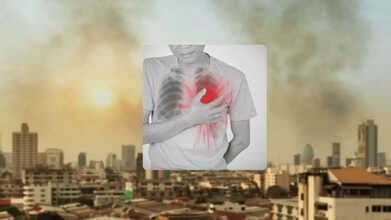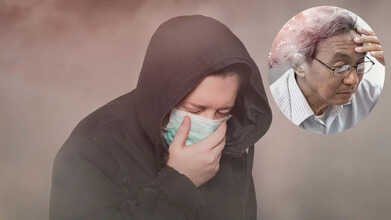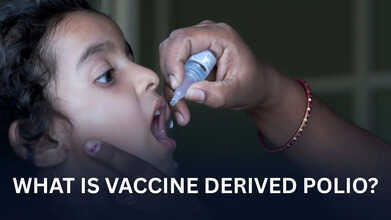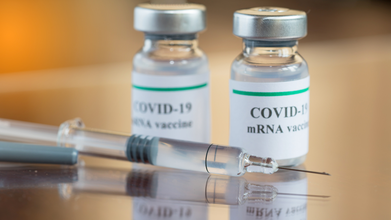- Health Conditions A-Z
- Health & Wellness
- Nutrition
- Fitness
- Health News
- Ayurveda
- Videos
- Medicine A-Z
- Parenting
- Web Stories
Delhi Air Pollution: AQI Crosses 400, Experts Warn of Rising Heart Problems

Credits: Canva
Delhi woke up under a thick blanket of haze on Tuesday, October 21, just a day after millions celebrated Diwali with fireworks, signalling the start of yet another pollution season that grips the city every winter.
Residents of what is already the most polluted capital in the world were once again forced to breathe toxic air, classified under the “severe” category. In several parts of the city, the Air Quality Index (AQI) climbed beyond 500, about ten times higher than what the World Health Organization considers safe. In some areas, the concentration of PM2.5 and PM10 particles hit alarming peaks of around 1,800, fifteen to twenty times higher than healthy limits.
Also Read: World Polio Day: How the Polio Vaccine Became a Lifesaving Shield Against a Global Disease
While we often link these conditions to respiratory problems, experts say the damage extends to the heart as well. To understand this connection, we spoke with Dr Manav Manchanda, Director & Head of Respiratory, Critical Care and Sleep Medicine at Asian Hospital.
How Does Air Pollution Affect The Heart?
An AQI of 400 or more means the air is loaded with fine dust, toxic gases, and heavy metals, levels so high they can strain even healthy lungs and hearts. What was once seen as a seasonal nuisance has now turned into a slow-moving public health crisis affecting millions across Delhi and other northern cities where winter smog pushes AQI readings into the danger zone.
These microscopic pollutants (PM2.5 and PM10) bypass the body’s natural filters in the nose and throat and reach deep into the lungs, settling in the bronchi and alveoli, the small air sacs responsible for oxygen exchange. The result is inflammation, oxidative stress, and swelling of the airways, often accompanied by excess mucus. Even healthy individuals may experience throat irritation, chest discomfort, or a persistent cough.
Also Read: mRNA COVID Vaccines Found To Help Cancer Patients Live Longer: Can This Be The Ultimate Cancer Cure?
But the harm does not stop at the lungs. According to Dr Manchanda, “Once particulate matter enters the bloodstream, it circulates through the body and causes inflammation in the blood vessels.” Over time, this inflammation stiffens the arteries, raises blood pressure, and can trigger irregular heart rhythms. Research has shown that even short-term exposure to severe pollution can increase the risk of heart attacks and strokes, particularly in those already prone to heart disease.
For healthy adults, this exposure can still cause fatigue, palpitations, or a faster resting heart rate as the body compensates for reduced oxygen intake.
What Short-Term Symptoms Should You Watch For Amid High AQI Levels?
During periods of poor air quality, experts recommend being alert to subtle but important warning signs. Common short-term symptoms include a dry cough, sore throat, breathlessness while climbing stairs, chest pain, watery eyes, or persistent headaches. Many also experience tiredness or dizziness because of reduced oxygen supply. These may appear mild but are early signs of inflammation and air toxicity.
To minimise risk, use an N95 or N99 mask before stepping out, avoid exercising outdoors when pollution levels peak, and consider using an indoor air purifier. Regular lung and heart screenings should no longer be limited to people with existing conditions.
Who Is More Vulnerable to Heart Diseases During High AQI?
According to the US Environmental Protection Agency, the groups most at risk include children, older adults, pregnant women, individuals with existing heart or lung conditions, and people from economically weaker sections. These populations are more vulnerable due to developing or aging organs, compromised immunity, and higher exposure to pollution, especially among those living near traffic or using solid fuels for cooking and heating.
How to Protect Yourself From Air Pollution?
1. Track AQI updates using apps like AQI India or AirVisual, or visit the Central Pollution Control Board’s website. On days when AQI levels exceed 200 (considered poor), avoid unnecessary outdoor activity.
2. Get a good air purifier, preferably one with a HEPA filter can help reduce these toxins. Place purifiers in rooms where you spend the most time, such as your bedroom or living area. If multiple devices are not an option, create a single “clean air zone” in one part of your home.
3. In today’s pollution levels, masks are no longer optional. Choose N95 or N99 masks, which are specifically designed to block PM2.5 particles, the same ones responsible for thousands of deaths each year.
4. Certain indoor plants, like peace lilies, areca palms, and snake plants, can help reduce indoor pollutants naturally. While they can’t replace purifiers, they contribute to better air quality and bring a touch of calm to your space.
5. During severe smog, stay indoors as much as possible. If you need to step out, try to do so in the afternoon when pollution tends to ease slightly. Avoid mornings and late evenings, when toxic particles linger close to the ground.
6. Include antioxidant-rich foods such as nuts, berries, and leafy vegetables to fight the oxidative damage caused by pollution. Omega-3 fatty acids from fish or flaxseeds are also beneficial for heart and lung health.
Drink plenty of water throughout the day as it helps flush out toxins, including those inhaled from polluted air.
Can Long-Term Air Pollution Exposure Raise Your Dementia Risk? Experts Explain

Credits: Canva
The State of Global Air 2025 report offers a worrying look at how the planet’s air quality is declining. It reveals that pollution has now become the second biggest cause of premature deaths worldwide, coming just after high blood pressure.
The report, prepared by the Health Effects Institute (HEI) in partnership with the University of Washington’s School of Medicine and the NCD Alliance in Geneva, draws attention to the sharp increase in pollution-linked diseases.
One of the most alarming findings is the growing connection between toxic air and dementia. This has raised a key question among people, can long-term exposure to polluted air actually trigger dementia? Here’s what experts and data reveal.
Rising Air Pollution in Delhi
Over the past several days, Delhi and its neighbouring cities have been trapped under a thick layer of smog, with air quality swinging between “poor” and “very poor.” The situation worsened sharply after Diwali, when fireworks filled the air with dense smoke. Reports noted that this was Delhi’s worst post-Diwali air quality in four years.
Every winter, the city faces this predictable yet avoidable crisis. Dr Arjun Khanna, pulmonologist at Amrita Hospital, told us that his phone has been “ringing non-stop” since the Diwali weekend. “We are seeing a surge in patients with breathing difficulties and sore throats,” he said. “This year’s winter is expected to be harsher, which will make the air quality even worse. The volume of firecrackers has been overwhelming, the smog is already visible, and the weather feels heavy and dull.”
He warned that the coming weeks will be particularly tough for Delhi-NCR residents and urged people to take precautions seriously.
Is Long-Term Air Pollution Contributing to Dementia?
Air pollution is no longer limited to the lungs or heart as now, it is also being tied to neurological decline. According to the State of Global Air 2025 report, 626,000 deaths related to dementia in 2023 were linked to long-term exposure to air pollution. That means nearly 29% of all dementia deaths globally had an environmental cause. For the first time, the report also measured how much healthy life pollution costs humanity, 11.6 million years lost due to its contribution to dementia.
With more than one in four dementia deaths connected to polluted air, the report underlines a growing risk for ageing populations worldwide. Fine particulate matter, known as PM2.5, harms not just the respiratory and cardiovascular systems but also the brain.
How Does Air Pollution Damage The Brain?
The report explains that microscopic pollutants can travel from the lungs into the bloodstream and eventually reach the brain. Once there, these particles trigger inflammation and oxidative stress, leading to damage in brain cells and tissues. This accelerates neurodegeneration and increases the risk of Alzheimer’s disease, vascular dementia, and mild cognitive impairment, all conditions marked by memory loss and reduced thinking ability.
Researchers also found that air pollution can disrupt brain development in children and young adults, increasing the risk of autism, anxiety, and depression later in life.
While lifestyle factors such as smoking or poor diet remain major contributors to dementia, experts warn that pollution exposure is far more widespread affecting billions of people. Even a small rise in individual risk, therefore, results in a major global health burden.
Air Pollution’s Link to Other Non-Communicable Diseases
The data from the report also reveal that pollution drives a wide range of non-communicable diseases (NCDs):
- 1 in 2 deaths from chronic obstructive pulmonary disease (COPD) were caused by air pollution.
- 1 in 4 heart disease deaths were linked to exposure to polluted air.
- More than 1 in 4 dementia deaths were tied to pollution.
- Nearly 1 in 6 diabetes deaths were caused by poor air quality.
Overall, 95% of all air pollution deaths occurred among people over the age of 60, and 6.8 million deaths were due to NCDs.
India’s Struggle Against Toxic Air
India’s Supreme Court recently relaxed its blanket ban on firecrackers in New Delhi during Diwali, allowing limited use of “green crackers” which is a cleaner alternative designed to cut emissions by about 30%. The court permitted their use during specific hours, but as in past years, compliance was poor.
New Delhi and its wider metropolitan area is home to over 30 million people but still these cities remain among the most polluted regions on Earth, particularly during the winter. The combination of Diwali fireworks, low temperatures, and smoke from crop burning in nearby states consistently traps the city under layers of toxic haze.
Authorities have announced temporary measures such as restricting construction, banning diesel generators, and limiting vehicle movement. However, environmentalists stress that these are short-term fixes. Long-lasting change, they argue, requires cleaner energy policies, stricter emission standards, and greater public accountability to prevent this annual health emergency.
What Is Vaccine-Derived Polio And How Is It Triggering New Polio Cases In India?

Credits: Canva
A two-year-old child from Meghalaya’s West Garo Hills district reportedly tested positive for polio in 2025, a highly contagious and potentially fatal disease that once crippled millions before being nearly wiped out by vaccines.
Officials from the Union Health Ministry confirmed that the infection was vaccine-derived, stressing that India’s polio-free status remains unaffected. But what exactly does “vaccine-derived” mean, and is it dangerous? Can such a case spread from one person to another? Let’s break it down.
What Is Vaccine-Derived Polio?
A vaccine-derived poliovirus (VDPV) is a mutated form of the weakened live virus used in the oral polio vaccine (OPV). According to the Centers for Disease Control and Prevention (CDC), if this weakened strain continues to circulate among communities with poor vaccination coverage or replicates inside a person with a weak immune system, it can revert to a version capable of causing paralysis and illness.
Interestingly, the oral polio vaccine (OPV) has played a crucial role in eliminating wild poliovirus globally. It contains one or more weakened strains of the virus and is administered as oral drops, which help build immunity in the gut, stopping the virus from spreading. However, when too few people are vaccinated, the weakened virus can continue moving from person to person, mutating over time, and eventually regaining its disease-causing ability.
However, it is important to remember that polio drops are safe and have helped nearly every country eliminate the disease. Still, in extremely rare cases, especially among children with weak immune systems, the vaccine strain can cause infection.
Types Of Polio Vaccines
There are two kinds of vaccines used to protect against polio, one given orally and the other through injection.
Oral Polio Vaccine (OPV):
This is the most widely used vaccine in India. It contains a weakened version of the poliovirus that helps the body build immunity without causing illness. It is administered orally, usually as drops, and is used during mass campaigns such as National Immunization Days.
Inactivated Polio Vaccine (IPV):
IPV, on the other hand, contains a killed version of the poliovirus and is given as an injection. It forms part of India’s routine immunization schedule and is often delivered in combination with other vaccines.
In India, both vaccines are used, though OPV remains preferred because it’s simple to administer during large-scale drives.
Vaccine-Derived Polio Cases Detected In India
India’s last recorded wild poliovirus case occurred years ago, but in 2024, a two-year-old child in Meghalaya was confirmed to have vaccine-derived polio. Officials clarified that this does not affect the country’s polio-free certification, since the virus involved was vaccine-derived rather than wild.
Earlier instances have been reported as well. In 2011, a vaccine-derived virus was detected in West Bengal’s Howrah district. Another case emerged in Beed district, Maharashtra, where an 11-month-old boy with an immune disorder developed brain lesions after contracting the vaccine-derived strain and sadly passed away.
In 2021, Kerala also documented a rare transmission case: a seven-month-old baby with Severe Combined Immunodeficiency (SCID) received the oral vaccine but couldn’t clear the weakened virus from his system. The virus was later passed to his father through the fecal-oral route, as reported by The Times of India.
Why Are Vaccines Triggering Fresh Polio Cases In India?
Vaccine-derived polio tends to appear in communities where immunization coverage is low. The weakened virus from OPV can circulate in such areas, undergo genetic changes, and, over time, transform back into a version capable of causing paralysis, the World Health Organization (WHO) explains. When this mutated strain starts spreading in the community, it’s known as a “circulating vaccine-derived poliovirus” (cVDPV).
In India, the few vaccine-derived cases reported so far have primarily been seen in children with weak immune systems, who are unable to fight off even the weakened vaccine virus. Poor sanitation and incomplete vaccination coverage further increase the risk of such mutations.
Can Vaccine-Derived Polio Be Prevented?
The oral polio vaccine remains highly effective at preventing the spread of the virus from person to person, and it is easy, drop-based delivery has made it the foundation of the global eradication effort. However, one drawback is that, on rare occasions, it can cause infection or transmit the weakened virus to others, as noted by the CDC.
To reduce this risk, many experts advocate switching entirely to the inactivated polio vaccine (IPV). Yet IPV has its own challenges: it requires trained medical staff for injection, which could lower immunization rates, and unlike OPV, it does not stop virus transmission through the gut.
Countries such as the United States and Canada have already moved entirely to IPV. India, however, continues to use both forms, IPV as part of routine childhood immunization and OPV for children under five during Pulse Polio campaigns.
Polio vaccination remains the best protection against both wild and vaccine-derived strains. Maintaining high IPV coverage is essential to keeping India and the rest of the world polio-free, ensuring that even rare mutations never regain a foothold.
mRNA COVID Vaccines Found To Help Cancer Patients Live Longer: Can This Be The Ultimate Cancer Cure?

(Credit-Canva)
COVID vaccines have often been at the center of discussions, mostly for their side effects and potential risks. But this time the spotlight is on something positive - COVID vaccine is being linked to prolonging the life of cancer patients. But not every COVID vaccine, only mRNA.
Scientists at the University of Florida and the University of Texas MD Anderson Cancer Center discovered something very important. They found that people with serious lung or skin cancer who got an mRNA COVID-19 vaccine around the time they started their anti-cancer treatment, which is immunotherapy, lived much longer than those who didn't get the shot. Specifically, the vaccine seemed helpful if it was given within 100 days of starting the cancer treatment.
Also Read: Is Bubble Tea Putting Your Health at Risk? Experts Warn About Lead Exposure
This discovery is a huge leap forward in the research to use mRNA technology—the same tech used for the COVID shots—to teach the body's natural defense system to fight cancer. It builds on previous studies and brings us closer to a potential universal cancer vaccine that could make existing cancer drugs work even better for more people.
Can mRNA Vaccine Cure Other Diseases Than COVID?
The new study, which was written about in the journal Nature, comes from eight years of work by Dr. Sayour on mixing tiny fat bubbles with mRNA. mRNA is a natural material in your body that carries the blueprint for making proteins.
Dr. Sayour's lab previously had an unexpected finding: to make the immune system strongly attack a tumor, they didn't have to target a specific piece of the cancer. Instead, they could just boost the immune system as if it were getting ready to fight a virus. This led to an experimental mRNA shot (similar to the COVID vaccines) that, when mixed with standard cancer drugs, strongly fought tumors in mice.
This success made another team member, Dr. Adam Grippin, wonder: Could the standard COVID-19 mRNA vaccine act the same way as their experimental "nonspecific" one? To find out, the researchers looked at the medical records of patients with advanced lung and skin cancers treated between 2019 and 2023.
What Are mRNA Vaccines And Which Ones Are Approved For Usage?
The Mayo Clinic explains that the mRNA vaccine gives your cells a set of instructions on how to build the harmless spike protein that is on the COVID-19 virus. The vaccine sends the mRNA into your muscle and your muscle cells or other defense cells read these instructions and start making the spike protein. This is how your body prepares to protect you from the virus. Moderna and Pfizer-BioNTech are both mRNA vaccines available in the US.
Also Read: Not All Antidepressants Affect Your Body The Same; Here’s What You Need To Know About Side Effects
How Have mRNA Vaccines Helped Our Health?
These findings come from checking the medical files of over 1,000 patients. It's important to know that this is only the first look at the information. Scientists must confirm these results in a strict new study called a randomized clinical trial. If the results hold up, this study could change cancer treatment forever.
The study clearly shows how powerful mRNA medicines are. The findings also point to an unexpected benefit from the government's quick push for COVID-19 vaccines (called Operation Warp Speed), showing how that effort continues to help save American lives.
The data analysis showed that getting a COVID mRNA vaccine within 100 days of starting cancer drugs was linked to significantly longer lives. This was most true for patients whose bodies weren't expected to fight their tumors very well on their own.
For 180 advanced lung cancer patients who got the vaccine, the average survival time was nearly doubled, going from 20.6 months to 37.3 months, compared to patients who didn't get the shot. For patients with widespread skin cancer (melanoma), the average survival went up from 26.7 months to somewhere between 30 and 40 months. Importantly, getting non-mRNA shots, like the regular flu vaccine, did not change survival time.
Should mRNA Vaccines Become Cancer Treatment?
To make sure their findings were real, the UF researchers did experiments with mice, giving them immunotherapy drugs along with an mRNA vaccine for the COVID virus. These tests showed that the combination could make cancers that usually ignored treatment suddenly shrink and stop growing.
The next necessary step is to launch a big clinical trial to confirm these findings. If they are proven true, scientists could design an even better, general-purpose vaccine to help cancer patients. For people with late-stage cancer, the extra time they gain from this kind of treatment would be priceless. Dr. Sayour believes that even a small boost in survival, like 5% or 10%, means a huge amount to these patients, especially if this treatment can work for many different kinds of cancer.
© 2024 Bennett, Coleman & Company Limited

